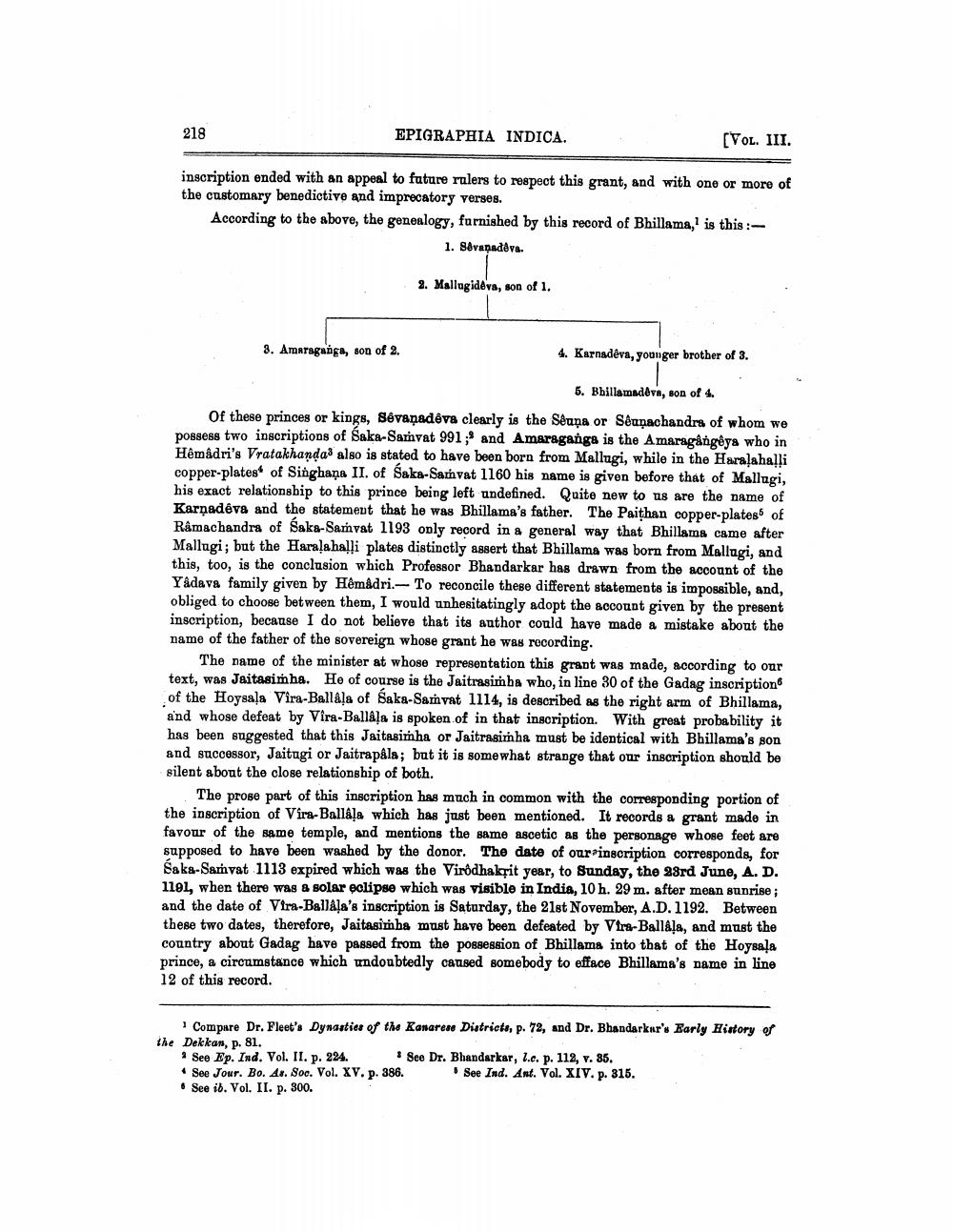________________
218
EPIGRAPHIA INDICA.
(VOL. III.
inscription ended with an appeal to future rulers to respect this grant, and with one or more of the customary benedictive and imprecatory verses. According to the above, the genealogy, furnished by this record of Bhillama," is this :
1. Sevaņadeva.
2. Mallugideva, son of 1.
8. Amaragange, son of 2.
4. Karnadeva, younger brother of 3.
5. Bbillamadeva, son of 4. Of these princes or kings, Sevaņadêve clearly is the Sềuna or Séanachandra of whom we possess two inscriptions of Saka-Samvat 991;9 and Amaraganga is the Amaragångêya who in Hêmadri's Vratakhanda: also is stated to have been born from Mallugi, while in the Haralahalli copper-plates of Singhaņa II. of Saka-Samvat 1160 his name is given before that of Mallugi, his exact relationship to this prince being left undefined. Quite new to us are the name of Karnadeva and the statement that he was Bhillama's father. The Paithan copper-platess of Ramachandra of Saka-Samvat 1193 only record in a general way that Bhillams came after Mallugi; but the Haralahalli plates distinctly assert that Bhillama was born from Mallugi, and this, too, is the conclusion which Professor Bhandarkar has drawn from the account of the Yadava family given by Hêmådri.- To reconcile these different statements is impossible, and, obliged to choose between them, I would unhesitatingly adopt the account given by the present inscription, because I do not believe that its author could have made a mistake about the name of the father of the sovereign whose grant he was recording.
The name of the minister at whose representation this grant was made, according to our text, was Jaitasimha. He of course is the Jaitrasimba who, in line 30 of the Gadag inscription of the Hoysala Vira-BallAla of Saka-Samvat 1114, is described as the right arm of Bhillama, and whose defeat by Vira-Ballkļa is spoken of in that inscription. With great probability it has been suggested that this Jaitasimha or Jaitrasimha must be identical with Bhillama's son and successor, Jaitugi or Jaitrapala; but it is somewhat strange that our inscription should be silent about the close relationship of both.
The prose part of this inscription has much in common with the corresponding portion of the inscription of Vira-Ballkļa which has just been mentioned. It records a grant made in favour of the same temple, and mentions the same ascetic as the personage whose feet are supposed to have been washed by the donor. The date of our inscription corresponds, for Saka-Samvat 1113 expired which was the Virodhaksit year, to Sunday, the 23rd June, A. D. 1191, when there was a solar eclipse which was visible in India, 10 h. 29 m. after mean sunrise ; and the date of Vira-Ba10Aļa's inscription is Saturday, the 21st November, A.D. 1192. Between these two dates, therefore, Jaitasimba must have been defeated by Vira-Ball&la, and must the country about Gadag have passed from the possession of Bhillams into that of the Hoysala prince, a circumstance which undoubtedly caused somebody to efface Bhillama's name in line 12 of this record.
Compare Dr. Fleet's Dynasties of the Kanarese Districts, p. 72, and Dr. Bhandarkar'. Early History of the Dekkas, p. 81. * See Ep. Ind. Vol. II. p. 224.
See Dr. Bhandarkar, l.e. p. 112, v. 85. • See Jour. Bo. As. Soc. Vol. XV. p. 386. See Ind. Ant. Vol. XIV. p. 315. • See ib. Vol. II. p. 300.




